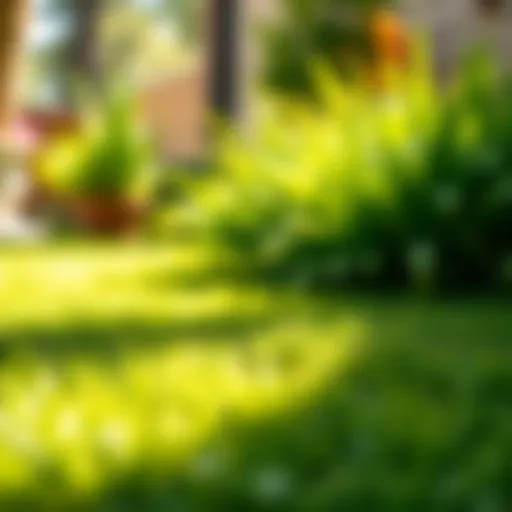The Modern Kitchen Backsplash: A Comprehensive Guide
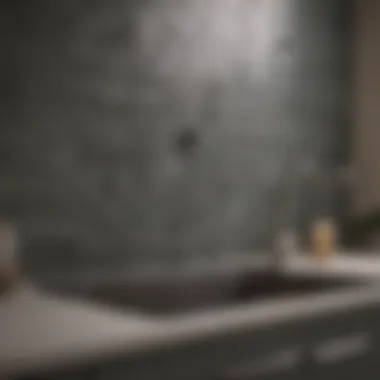

Intro
Kitchen backsplashes play a significant role in modern design. They are not just placeholders; they add style, protect walls, and offer countless options in terms of materials and colors. In a world where kitchen aesthetics are as important as functionality, backsplashes are often the focal point that enhances the overall look of the space. A well-chosen backsplash can tie together the design elements of a kitchen, making it visually appealing while also serving practical purposes.
This comprehensive guide delves into the various aspects of modern kitchen backsplashes. Homeowners and design enthusiasts will gain insights into trending styles and color palettes that define contemporary kitchens. Additionally, understanding maintenance considerations ensures that your backsplash not only looks great upon installation but remains so over time. From sleek tiles to innovative materials, this guide aims to inform and inspire informed choices.
Design Inspirations
When considering a backsplash, it's essential to explore various designs that can complement your kitchen's overall appearance.
Trending Styles
Modern backsplashes come in a myriad of styles, reflecting the evolving tastes of homeowners. Here are some of the most favored trends:
- Subway Tiles: Classic and versatile, subway tiles provide a clean look. Often seen in white or light shades, they can be arranged in various patterns for added interest.
- Geometric Patterns: For a bold statement, geometric tiles are an excellent choice. They add dynamic visual appeal and can be customized with different colors.
- Natural Stone: Materials such as slate, granite, and marble bring texture and depth. Natural stone offers a rustic charm while remaining elegant.
- Glass Tiles: These can provide a sleek, modern appearance. Glass tiles reflect light, which can make a kitchen feel more open and spacious.
Color Palettes
Color choice is crucial for creating the right mood in your kitchen. Certain paletes can enhance the overall design while still aligning with personal taste:
- Neutral Shades: White, grey, and beige are timeless. They create a sophisticated background, allowing other elements in the kitchen to shine.
- Bold Colors: Deep blues, greens, or reds can serve as eye-catching focal points. Used sparingly, they bring energy to the space without overpowering it.
- Monochromatic Schemes: Utilizing various shades of a single color can create a cohesive and minimalist look.
"The right backsplash can transform a kitchen from ordinary to extraordinary. It reflects personal style while adding functionality."
Modern kitchen backsplashes must also be practical. This includes considerations like maintenance and upkeep, which will be addressed in the following sections.
Preamble to the Modern Kitchen Backsplash
The kitchen backsplash holds a significant position in the realm of modern interior design. It serves both functional and aesthetic purposes, becoming a focal point in kitchen decor. This guide aims to explore various aspects of the modern kitchen backsplash and its appeal to homeowners and design enthusiasts alike.
Definition and Purpose
A backsplash is a protective wall covering situated behind sinks and countertop areas. This practical element prevents water, grease, and food residue from harming the wall substance. Additionally, backsplashes provide an opportunity for personal expression through design.
The purpose of a kitchen backsplash goes beyond mere protection. It enhances the kitchen's overall look and harmonizes with adjacent features such as cabinetry and countertops. Designers often select distinct materials and colors that elevate the kitchen's ambiance. Thus, while functionality is essential, the beauty of a carefully chosen backsplash contributes significantly to the kitchen's character.
Historical Evolution
The evolution of kitchen backsplashes traces back to the early days of cooking spaces. Originally, these areas were simply sealed off using plaster or paint. As time passed, various materials began to emerge. By the mid-20th century, ceramic tiles became popular for their durability and ease of cleaning.
In contemporary design, the options for backsplashes have expanded immensely. Now, materials such as glass, stone, and metal offer various styles and finishes that cater to personal tastes. Homeowners can experiment with different combinations, textures, and patterns, resulting in uniquely crafted spaces. The transition from simple wall protection to creative design opportunity illustrates the adaptability and significance of the modern kitchen backsplash.
Materials for Modern Backsplashes
The selection of materials for kitchen backsplashes plays a crucial role in the overall aesthetics and functionality of the space. Choosing the right material can elevate the design of the kitchen, provide necessary protection from water, and serve as a focal point. Each material has unique characteristics, making it important to consider factors such as durability, maintenance, and style before deciding. Furthermore, understanding the benefits and limitations of various materials can significantly enhance a homeowner's or designer's decision-making process.
Ceramic Tiles
Ceramic tiles are a time-tested option for kitchen backsplashes. Available in a wide array of colors, patterns, and finishes, they offer versatility to match virtually any kitchen decor. One significant advantage of ceramic tiles is their durability; they are resistant to heat and moisture, which are common in kitchen environments. These tiles are also easy to clean, requiring only a damp cloth and mild detergent.
However, the installation process can be somewhat labor-intensive. Precision in cutting and spacing tiles is essential to achieve a polished look.
Some key considerations include:
- Variety: From glossy to matte finishes, ceramic tiles can fit various aesthetic needs.
- Cost-effectiveness: They are typically affordable, making them suitable for budget-conscious remodels.
- Customization: Many homeowners opt for custom patterns or shapes for a unique touch.
Glass Panels
Glass panels have gained popularity in modern kitchens for their sleek appearance and ability to reflect light. This material offers a contemporary and minimalist look, making spaces feel larger and brighter. Glass backsplashes are often available in a range of colors and can also be backlit for added effect.
In terms of maintenance, glass is relatively easy to clean, as it does not stain easily. However, it may require more attention to prevent scratches. Installation can be trickier compared to tiles, often necessitating professional help.
Key points to consider include:
- Aesthetic Appeal: They provide a high-end look.
- Versatility: Glass can be installed in various forms, including sheets and mosaic designs.
- Light Reflection: Enhances the overall brightness of the kitchen.
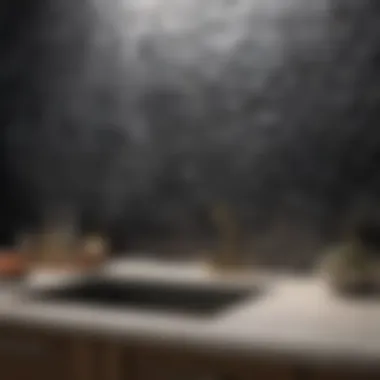

Natural Stone
Natural stone, such as granite, marble, or limestone, offers a timeless elegance to any kitchen. Each slab is unique, adding character to the space. Stone backsplashes are incredibly durable, capable of withstanding everyday wear and tear. They are also heat resistant, making them ideal for cooking areas.
However, maintenance can be a challenge. Natural stone typically requires sealing to prevent stains and damage from spills. Additionally, the weight of stone may complicate installation, often necessitating professional expertise.
Considerations for natural stone include:
- Durability: Long-lasting and can withstand heavy use.
- Investment: Higher initial cost but adds significant value.
- Unique Patterns: No two pieces are alike, adding individuality to the design.
Metal Backsplashes
Metal backsplashes, including stainless steel and copper, present an industrial aesthetic that can complement modern kitchens. They are typically very durable and can withstand heat, moisture, and impact. Metal surfaces are also relatively easy to clean, though they can show fingerprints and scratches over time.
Installation can be straightforward, with many metal options available in sheets or tiles. One downside is that they may be prone to denting or warping if not cared for properly.
Key benefits include:
- Strength: Highly resistant to damage.
- Contemporary Flavor: Fits well in modern and industrial-style kitchens.
- Hygiene: Metal surfaces are non-porous and resistant to bacteria.
Wood and Composite Materials
Wood and engineered composite materials provide a warm, inviting look to kitchens. They can create a rustic or farmhouse feel, appealing to many homeowners. One hybrid option is bamboo, known for its sustainability.
While wood backsplashes can add charm, their maintenance is a consideration. Wood can be vulnerable to moisture and may warp or discolor if not sealed. Composite materials, on the other hand, can offer similar aesthetics with enhanced durability and less maintenance.
Considerations for wood and composites include:
- Aesthetic Versatility: Can fit various styles from modern to traditional.
- Maintenance Needs: Requires sealing and careful cleaning.
- Sustainability: Many composite materials are eco-friendly and designed for longevity.
Design Styles for Modern Kitchens
The design style of a kitchen backsplash plays a pivotal role in how the space is perceived. It goes beyond mere functionality, contributing significantly to the overall aesthetic of the kitchen. A well-chosen backsplash can tie together various design elements, enhancing the visual appeal while also reflecting personal taste. Each style carries distinct characteristics, benefits, and considerations that cater to different preferences.
Minimalist Approaches
Minimalism focuses on simplicity and functionality. In minimalistic kitchens, backsplashes often use neutral colors and straightforward designs. The objective is to create serene spaces with clean lines. Using materials like white ceramic tile or smooth glass can enhance the minimalist look. The advantages include ease of maintenance and an unobtrusive appearance.
Minimalist backsplashes fulfill a dual purpose by blending seamlessly into the overall kitchen design while providing a clean surface that is easy to clean. Homeowners can benefit from selecting materials that are non-reflective, as these add to the understated elegance.
Industrial Influences
Industrial design is recognizable by raw elements, exposed brick, and metallic finishes. A backsplash in this style often includes materials like stainless steel or reclaimed wood.
These choices bring texture and depth to the kitchen, making it feel more dynamic. Industrial backsplashes can also incorporate rustic patterns or uneven finishes, emphasizing their authentic character. For those who appreciate an edgy aesthetic, this design style offers a bold statement while maintaining practicality.
Farmhouse Aesthetics
Farmhouse aesthetics evoke a sense of warmth and comfort. Backsplashes in this style typically feature traditional tiles or even painted woods. Colors are often soft and muted, promoting a cheerful yet relaxed atmosphere.
The farmhouse style embraces both functionality and charm, making it ideal for family kitchens where cooking and gathering occur frequently. Mosaic tiles in pastel shades or large, glossy tiles can create a wholesome look, appealing to homeowners who value nostalgia and tradition.
Contemporary Bold Statements
Contemporary kitchens often embrace bold colors and unique patterns. A backsplash in this style might feature large-scale geometric designs or vibrant hues, allowing homeowners to express their personality.
This approach encourages creativity and can serve as a focal point in the kitchen. Contemporary backsplashes challenge conventional designs by incorporating unexpected materials, such as metal or glass in intricate patterns. These have the power to transform a kitchen into an artful environment.
The choice of backsplash design significantly affects the kitchen’s overall ambiance.
It is essential for homeowners to consider how each design style meshes with their vision. By understanding their preferences and lifestyle, they can better select a backsplash style that will enhance not just the aesthetics but also the functionality of their kitchen.
Color and Pattern Considerations
Color and pattern are crucial elements in the design of modern kitchen backsplashes. They can dramatically influence the overall appearance and feel of the kitchen. The right combination can unify the space, enhance architectural features, and reflect personal style. When selecting a backsplash, it’s important to consider how colors and patterns interact with other kitchen elements, such as cabinets, countertops, and appliances. The appropriate choices will not only beautify the kitchen but can also improve the functionality of the space.
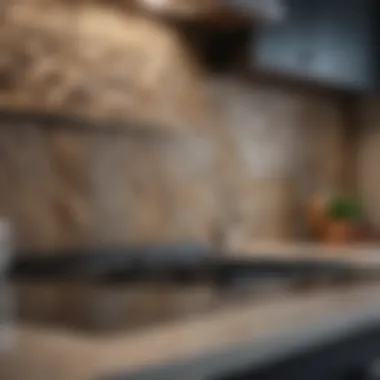

Choosing the Right Color Palette
A well-thought-out color palette can set the tone for your kitchen. Here are some key points to remember:
- Harmonious Colors: Choose colors that complement or contrast effectively with existing elements. For instance, a white kitchen might benefit from bold colored tiles to create focal points.
- Mood Considerations: Color psychology plays a role in how a space is felt. Warm tones like reds and yellows can create a vibrant atmosphere, while cool tones like blues and greens promote calmness.
- Consistency: Maintaining a consistent color theme throughout the home is important for visual flow. Make sure the colors align with adjacent rooms.
Patterns and Textures
Patterns and textures add depth and interest to a kitchen backsplash. Different styles can drastically change the look of the kitchen. Here are some considerations when choosing patterns and textures:
- Geometric Designs: Clean, geometric patterns can modernize a space, creating a sleek aesthetic. They are suitable for contemporary style kitchens.
- Textured Surfaces: Textures can also enhance the tactile quality of a backsplash. Options like 3D tiles or irregular stone can create a dynamic visual experience that catches the light differently.
- Subway Tiles: While classic, subway tiles can be arranged in various patterns, like herringbone or stacked, allowing creativity and uniqueness.
"The right pattern can transform an ordinary backsplash into a piece that captivates and engages anyone who enters the kitchen."
When considering patterns and textures, it is important to align them with the overall kitchen design. Avoid overwhelming the space. Instead, aim for a balanced approach that emphasizes key elements without creating visual chaos.
Installation Techniques
The process of installing a kitchen backsplash involves more than simply adhering materials to a wall. It represents a critical phase that can influence both the appearance and durability of the finished design. Understanding proper installation techniques allows homeowners and designers to achieve results that align with their aesthetic desires and functional needs. This section delves into crucial elements such as planning, execution, and selecting the right approach for their specific circumstances. Proper installation minimizes future maintenance troubles, saving time and money down the line.
Pre-Installation Planning
Planning before installation is essential. This phase involves several key considerations:
- Design Visualization: Homeowners should envision how the backsplash will complement the overall kitchen theme.
- Measurement Accuracy: Precise measurements must be taken to ensure all materials fit correctly after installation. Mistakes can lead to wasted materials and added costs.
- Material Selection: Different materials may require specific installation techniques. Knowing this ahead of time saves effort.
- Environmental Factors: Ensure that the selected materials can withstand kitchen conditions, such as heat and moisture. This can prevent issues like warping or discoloration.
Taking these steps seriously during pre-installation can lead to a smoother installation process.
DIY Installation vs. Professional Help
Choosing between DIY installation and hiring a professional is a significant decision. Each option has its advantages and drawbacks:
- DIY Installation:
- Professional Help:
- Cost Savings: Typically cheaper as homeowners avoid labor costs.
- Control Over Design: Homeowners can customize their design as they see fit.
- Skill Development: Installing the backsplash can be a great opportunity to learn new skills.
- Expertise: Professionals bring experience and knowledge that often results in a higher quality finish.
- Time Efficiency: Hiring experts saves time, especially for complex projects.
- Warranty Options: Many professionals offer warranties on their work, providing security against potential issues.
Assessing one's skill level, budget, and the complexity of the chosen design is central to making the right choice.
Common Installation Methods
Different techniques can be employed to install a backsplash. Some of the common methods include:
- Mortar and Grout Method: A traditional approach, particularly for ceramic and stone tiles. Mortar secures the tiles to the wall, followed by grout to fill gaps and provide a finished look.
- Adhesive Sheets: Some materials, like glass or metal, come with adhesive backing. This can greatly simplify the installation and is suitable for smaller projects.
- Panel Systems: Prefab panel systems provide an easy-to-install option that can be fitted over existing walls without much fuss.
Regardless of the method chosen, ensuring a clean and careful approach during installation can lead to a more polished final result. Successful installation techniques enhance both the beauty and functionality of the kitchen backsplash.
Maintenance of Kitchen Backsplashes
Maintenance of kitchen backsplashes is vital for preserving their appearance and functionality over time. Given that backsplashes are exposed to splashes, spills, and cooking residues, regular upkeep is essential. Proper maintenance not only enhances the aesthetic appeal but also prolongs the lifespan of the materials used. Homeowners, interior design enthusiasts, and anyone who frequently hosts gatherings should be aware of best practices for maintaining these areas.
Cleaning Procedures
To keep a backsplash looking its best, establishing a regular cleaning routine is important. Different materials require specific cleaning methods. For instance, ceramic tiles typically need simple soap and water, while natural stone may require pH-neutral cleaners to avoid damage.
Here are some suggested cleaning procedures for various backsplash materials:
- Ceramic and Porcelain Tiles: Use a mixture of warm water and mild detergent. A soft cloth or sponge works well to avoid scratching the surface.
- Glass Panels: Glass cleaner or vinegar diluted with water is effective. Avoid abrasive tools that could scratch the glass.
- Natural Stone: Use stone-specific cleaners, as acidic products can etch the surface. Soft microfiber cloths or sponges should be used for application.
- Metal Backsplashes: Stainless steel backsplashes can be cleaned with a soft cloth and mild detergent. Avoid metallic scrubbers to prevent scratching.
Additionally, routine inspection can prevent larger issues. Check for stains, discoloration or damage, addressing problems before they worsen. Regularly wiping down the backsplash after cooking can minimize the need for heavy cleaning.
Repair and Restoration Techniques
At times, despite care, backsplashes may require repairs or restoration. Understanding how to tackle common issues can save time and expenses in the long run.
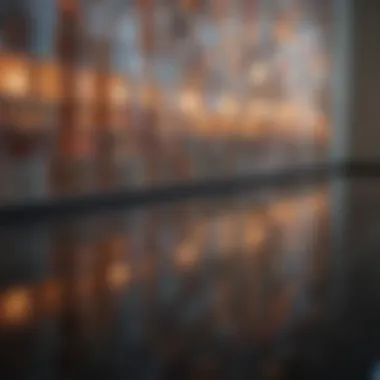

Some common repair techniques include:
- Replacing Individual Tiles: If tiles crack or chip, replace the damaged pieces. Ensure to use adhesive compatible with the existing tiles.
- Grout Repair: Discolored or cracked grout can be replaced using a grout saw or scraper. After removing the old grout, clean the area thoroughly before applying new grout.
- Re-sealing Natural Stones: Many natural stone backsplashes require regular sealing. A good rule of thumb is to seal every 1-3 years, depending on usage and type of stone. Follow manufacturer instructions for best results.
- Polishing Metal Surfaces: For metal backsplashes, polishing can restore shine and remove minor scratches. Use specialized metal polish to enhance appearance.
Remember: Proper maintenance and timely repairs ensure your backsplash remains a beautiful and functional element of your kitchen.
In summary, a well-maintained backsplash not only enhances the kitchen's look but also reflects the homeowner's care for their space. Regular cleaning and timely repairs are key to preserving both utility and beauty.
Trends in Modern Kitchen Backsplashes
As the heart of the home, the kitchen often reflects the latest trends in design and functionality. Keeping up with trends in modern kitchen backsplashes is vital for homeowners seeking to enhance their living spaces. A backsplash goes beyond mere decoration; it serves as a crucial element that marries form and function. Understanding contemporary preferences can guide choices that resonate with individual style while also increasing property value.
Sustainable Materials
In recent years, there has been a growing emphasis on sustainability within design, particularly in kitchens. Sustainable materials, such as recycled glass, bamboo, and reclaimed wood, are increasingly chosen for backsplashes. These options not only reduce environmental impact but also bring unique textures and beauty to the kitchen.
- Recycled Glass: Leveraging pieces of post-consumer glass, it creates stunning mosaics that are both eco-friendly and visually appealing.
- Bamboo: Fast-growing and renewable, bamboo provides a warm aesthetic and is highly durable, making it ideal for kitchen environments.
- Reclaimed Wood: Using previously utilized materials offers a rustic charm, helping to tell a story while also being kind to the planet.
Choosing sustainable materials often aligns with the wider trend of environmental consciousness. Homeowners can feel a sense of pride in both the aesthetic and the ethical implications of their choices.
Smart Backsplash Technologies
The integration of technology into home design has influenced backsplashes significantly. Smart backsplash technologies have entered the market, turning a simple wall feature into a multifunctional asset.
- LED Lighting: Many modern backsplashes feature integrated LED lighting that enhances the kitchen's atmosphere while providing task lighting.
- Touchscreen Displays: Some advanced options now include screens that serve as recipe holders, entertainment displays, or even clock interfaces, making cooking more convenient.
- Sensor Technology: Certain backsplashes are designed to respond to touch or voice commands, thereby streamlining kitchen use.
These innovations not only add utility but also elevate the overall aesthetic of the kitchen, showcasing a modern lifestyle where technology and design converge seamlessly.
Artistic Touches
Artistic choices in backsplash design allow homeowners to express their personality and creativity. The trend leans towards customization, where backsplashes serve as canvases rather than mere functional elements.
Mosaic Designs: These can tell a story or create a pattern that speaks to the homeowner’s taste. They may incorporate colorful ceramics or various textures.
- Hand-Painted Tiles: These vibrant additions can introduce unique art-inspired designs, becoming statement pieces in the kitchen.
- Graphic Prints: Many homeowners have started opting for large decals or prints that challenge the traditional utility of the backsplash, allowing interpretation and creativity in a cooking space.
"Art in the kitchen can transform it into a lively space, showcasing personal style while enhancing functionality."
Budgeting for a Kitchen Backsplash
Understanding the budget for a kitchen backsplash is crucial for homeowners. It shapes the choices available for materials, installation, and overall design. A well-planned budget helps in avoiding unexpected costs downs the line, ensuring the project stays within financial limits. Keeping track of expenses can transform the experience from stressful to satisfying.
Cost of Materials
When budgeting for a kitchen backsplash, materials play a significant role. The type of materials selected greatly influences the overall expenditure. Here are common materials and their average costs:
- Ceramic Tiles: Ranges from $1 to $15 per square foot, depending on quality and design.
- Glass Panels: Average costs lie between $7 and $25 per square foot due to their aesthetic appeal and modern look.
- Natural Stone: Price varies widely, ranging from $10 to over $50 per square foot based on stone type and finish.
- Metal Backsplashes: Typically range from $6 to $30 per square foot. Steel tends to be less expensive, while copper can be on the higher end.
- Wood and Composite Materials: Costs here vary greatly but typically range from $5 to $25 per square foot.
It is essential to factor in these prices, as they affect the total budget. Consider both necessity and aesthetic appeal when choosing materials.
Understanding Labor Costs
Labor costs is another critical factor in budgeting for a backsplash. Prices for labor can vary widely based on location, experience of the installer, and complexity of the job. Generally, labor can add $40 to $100 per hour. Here are some costs to keep in mind:
- Simple Installations: If it is a straightforward tile job, expect around $10 to $30 per square foot for labor.
- Complex Installations: Projects that require custom cuts or patterns may increase labor costs to between $40 and $70 per square foot.
- DIY Considerations: Choosing to install the backsplash yourself can save a significant amount, but it requires skills and can lead to errors if not done correctly.
Always ask for multiple quotes to understand labor costs. This way, you can make informed decisions that align with your budget.
Tip: Keep some budget flexibility. Unforeseen expenses may emerge during installation, so it's wise to allocate an extra 10-20% of your budget for such cases.
Closure
The conclusion of this article emphasizes the significant role of kitchen backsplashes in modern design. A well-chosen backsplash can seamlessly blend functionality with aesthetic appeal, transforming an ordinary kitchen into a visually striking space. Homeowners should consider not just the visual impact but also the practical aspects. Selecting high-quality materials that are durable and easy to maintain enhances both beauty and longevity. Furthermore, understanding the budgeting aspect is crucial for successful project planning. Consideration of labor and material costs ensures that you are making informed choices.
Final Thoughts on Selection and Design
When selecting a backsplash, it is essential to have a clear vision of your design goals. Factors like color, texture, and material should align with the overall kitchen theme. For instance, a minimalist kitchen may benefit from sleek, neutral-colored tiles, while a farmhouse aesthetic could be complemented by rustic stone or patterned ceramics. Consider the patterns and colors that will best fit your cooking environment. The design should not only reflect your style but also accommodate the practical needs of daily use. Incorporating these elements leads to a coherent look that defines the kitchen.
The Future of Backsplash Design
Looking to the future, kitchen backsplashes are evolving with technology and sustainable design trends. Innovations such as smart backsplash technologies are becoming common, allowing for seamless integration with kitchen appliances and smart home systems. These systems offer functionalities like touch controls and integrated lighting, enhancing the cooking experience. Moreover, sustainable materials are gaining traction. Homeowners increasingly prioritize eco-friendly options, making choices that are both stylish and responsible. As trends continue to change, the modern kitchen backsplash is set to remain a focal point of both form and function.

